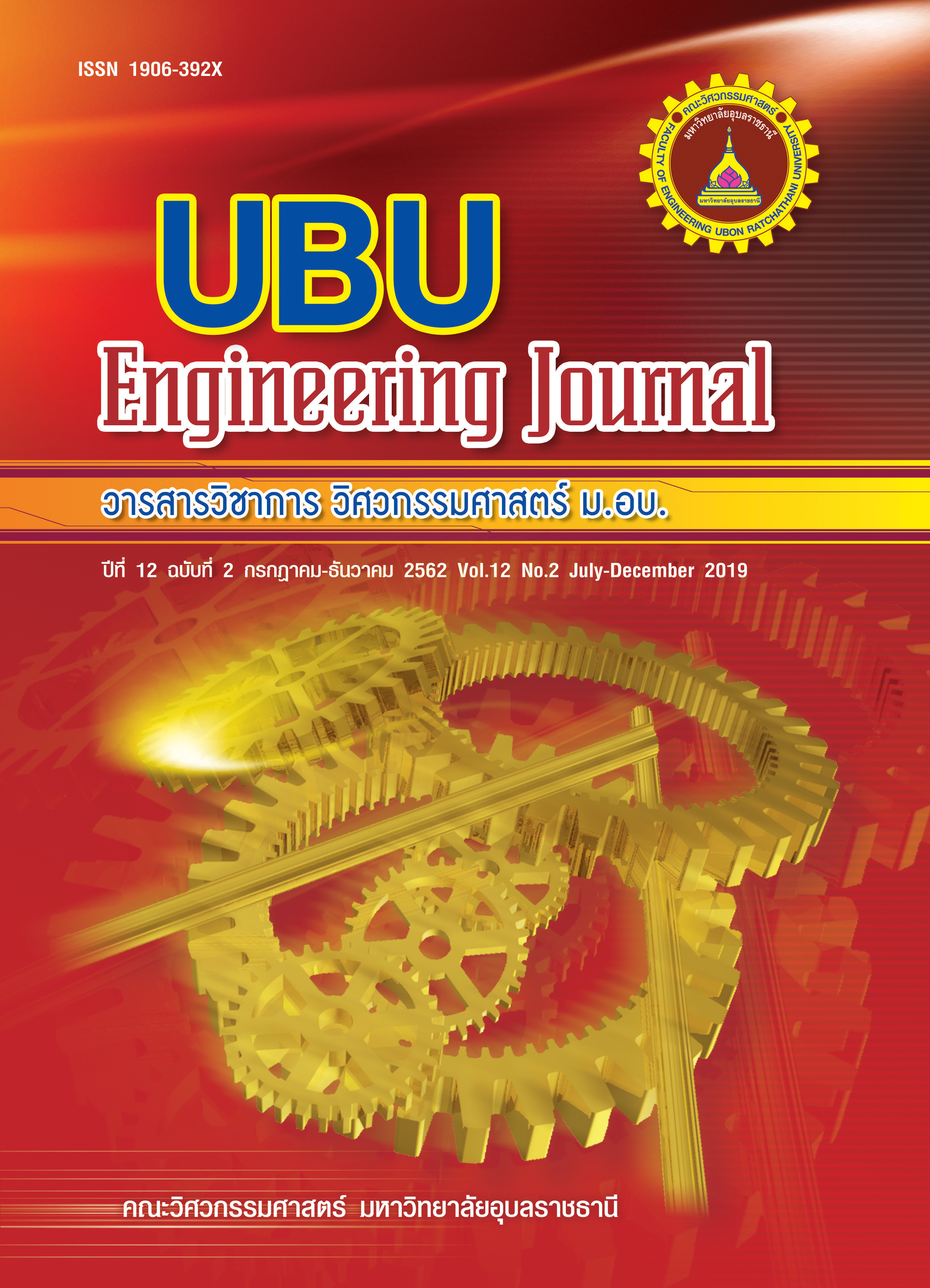การบำบัดน้ำเสียยางพาราโดยกระบวนการเฟนตัน
Main Article Content
Abstract
The objective of this research was to study characteristics of wastewater from para rubber cup lump and factors affecting Fenton process for treatment of para rubber wastewater. The treatment efficiency was also included. From the study, it was found that the color of wastewater from para rubber cup lump is black with pungent odor similar to sewage. From wastewater analysis, the value of pH, COD, Suspended Solids (SS), and Total Dissolved Solids (TDS) were approximately 5.52±0.05, 52,179±100.49 mg/L, 916.67±125.83 mg/L, and 25,350±636.40 mg/L, respectively. Important factors affecting Fenton process on treatment of para rubber wastewater were studied including pH (2, 3, and 4), contact time (90, 120, and 150 min), and ratio of H2O2:Fe2SO4•7H2O (5:1, 10:1, and 15:1 by mass). From the results, it was found that the highest COD removal efficiency was approximately 83.47±6.38 at pH 3, ratio of H2O2:Fe2SO4•7H2O at 5:1, and contact time of 90 min. For treatment of suspended solids, the best removal efficiency (51.30±8.26%) was found to be at pH 2, ratio of H2O2:Fe2SO4•7H2O at 15:1, and contact time of 90 min. For treatment of total dissolved solids, the TDS values increased. However, these values do not exceed the water quality standards (lower than 3,000 mg/L) issued by the industries and industrial estate. Except for the value of TDS at pH 2, ratio of H2O2:Fe2SO4•7H2O at 15:1, and contact time of 90 min, which was slightly higher than the standard.
Keywords
para rubber wastewater; rubber cup lump; Fenton processes; hydrogen peroxide; ferrous sulfate
Article Details
References
[2] Science News. บทความวิทยาศาสตร์. ยางธรรมชาติ. เข้าถึงได้จาก : http://www.electron.rmutphysics.com/science-news/index.php?option=com_content&task=view&id=141&Itemid=0 [เข้าถึงเมื่อ 4 กรกฎาคม 2561]
[3] การแถลงข่าวการค้าระหว่างประเทศของไทย เดือนพฤษภาคม ปี 2561, สำนักงานนโยบายและยุทธศาสตร์การค้า. เข้าถึงได้จาก : https://www.ditp.go.th/contents_attach/236374/236374.pdf [เข้าถึงเมื่อ 25 มีนาคม 2562]
[4] ระบบจัดการความรู้ การยางแห่งประเทศไทย. เข้าถึงได้จาก : http://km.rubber.co.th/index.php?option=com_content&view=article&id=134:2011-05-20-04-17-11 [เข้าถึงเมื่อ 4 กรกฏาคม 2561]
[5] รายงานฉบับสมบูรณ์ (Final Report) โครงการพัฒนาความร่วมมือด้านอุตสาหกรรมกับประเทศเพื่อนบ้าน(ยุทธศาสตร์การพัฒนาความร่วมมือด้านอุตสาหกรรมภายใต้กรอบโครงการพัฒนาเขตเศรษฐกิจสามฝ่ายอินโดนีเซีย-มาเลเซีย-ไทย: IMT-GT). เข้าถึงได้จาก : http://www.thaifta.com/trade/study/imtgt_chap5-1.pdf [เข้าถึงเมื่อ 4 กรกฎาคม 2561]
[6] สังคมออนไลน์ของคนเชียงราย. Chiangraifocus. เข้าถึงได้จาก http://www.chiangraifocus.com/forums/index.php?topic=742405.0 [เข้าถึงเมื่อ 4 กรกฎาคม 2561]
[7] แกมกาญจณ์ รักษาพราหมณ์, การประเมินสภาพปัญหาไฮโดรเจนซัลไฟด์ในบ่อหมักไร้อากาศของระบบบำบัดน้ำเสียโรงงานยาง, วิทยานิพน์วิทยาศาสตรมหาบัณฑิต สาขาการจัดการสิ่งแวดล้อม, 2539, มหาวิทยาลัยสงขลานครินทร์
[8] สุพัตรา เฉลียวพงศ์, สภาวะ pH ที่เหมาะสมของบ่อไร้อากาศในการบำบักน้ำเสียจากโรงงานน้ำยางข้น, วิทยานิพนธ์วิศวกรรมศาสตรมหาบัณฑิต สาขาวิชาวิศวกรรมเคมี, มหาวิทยาลัยสงขลานครินทร์, 2540
[9] อาภรณ์ รักเกิด, การประเมินปัญหาไนโตรเจนในน้ำเสียจากโรงงานยางและการกำจัดไนโตรเจน ด้วยระบบบ่อบำบัดน้ำเสียที่ใช้ มวลชีวะประเภทเกาะผิว, วิทยานิพนธ์วิทยาศาสตรบัณฑิต สาขาการจัดการสิ่งแวดล้อม, มหาวิทยาลัยสงขลานครินทร์, 2541
[10] พัฒนวรรณ วิทยกุล, การบำบัดซัลเฟตและก๊าซไฮโดรเจนซัลไฟด์ในน้ำเสียจากโรงงานน้ำยางข้นด้วยระบบบ่อไร้อากาศและระบบการกรองทางชีวภาพ, วิทยานิพนธ์วิทยาศาสตรบัณฑิต สาขาการจัดการสิ่งแวดล้อม, มหาวิทยาลัยสงขลานครินทร์, 2544
[11] อรัญ หันพงศ์กิตติกูล, การใช้ประโยชน์จากน้ำเสียของการทำยาง, วารสารยางพารา ปีที่ 2 ฉบับที่ 3. 2524: 141-146
[12] นัยทัศน์ ภู่ศรัณย์, ไพบูลย์ ธรรมรัตน์วาสิก, เสาวลักษณ์ จิตรบรรเจิดกุล, และ วรรณา วงศ์กรเชาวลิต, การศึกษาและวิเคราะห์สถานภาพปริมาณของเสียจากโรงงานแปรรูปผลิตผลการเกษตรในภาคใต้ของประเทศไทย เน้นอุตสาหกรรมยางพารา, ปทุมธานี : สำนักงานพัฒนาวิทยาศาสตร์และเทคโนโลยีแห่งชาติ, 2529
[13] siam watertech. การบำบัดน้ำเสีย. เข้าถึงได้จาก http://www.siamwatertech.com/%E0%B8%81%E0%B8%B2%E0%B8%A3%E0%B8%9A%E0%B8%B3%E0%B8%9A%E0%B8%B1%E0%B8%94%E0%B8%99%E0%B9%89%E0%B8%B3%E0%B9%80%E0%B8%AA%E0%B8%B5%E0%B8%A2.html [เข้าถึงเมื่อ 4 กรกฎาคม 2561]
[14] USP technologiesTM. Hydrogen Peroxide is a Powerful Oxidizer. เข้าถึงได้จาก http://www.h2o2.com/products-and-services/us-peroxide-technologies.aspx?pid=112&name=Hydrogen-Peroxide [เข้าถึงเมื่อ 4 กรกฎาคม 2561]
[15] Bigda R.J. Consider Fenton’s Chemistry for Wastewater Treatment. Acc. Chem. Eng. Prog. Res. 1995; 91: 62-66.
[16] Walling C. Fenton’s Reagent Revisited. Acc. Chem. Res. 1975; 8: 125-131.
[17] Arslan I.A. and Isil A.B. The effect of pre-ozonation on the H2O2/UV–C treatment of raw and biologically pre-treated textile industry wastewater, Water Science and Technology. 2002; 45: 297- 304.
[18] Kermer M. L. Mechanism of the Fenton reaction. Evidence for a new intermediate. Phys. Chem. Chem. Phys. 1999; 1: 3595-3605.
[19] M.Y. Ghaly, M.Y., Härtel, G., Mayer, R., and Haseneder, R. Photochemical oxidation of p-chlorophenol by UV/H2O2and photo-Fenton process. A comparative study. Waste Manage. 2001; 21 (11): 41-7.
[20] Benatti, C.T. and Tavares, C.R.G. Fenton´s Process for the Treatment of Mixed Waste Chemicals, Environmental and Analytical Update, 2012.
[21] Benatti, C.T.,Tavares, C.R.G., and Guedes, T.A. Optimization of Fenton’s oxidation of chemical laboratory wastewaters using the response surface methodology. Journal of Environmental Management. 2006; 80: 66–74.
[22] Malik, P. K., and Saha, S. K. Oxidation of direct dyes with hydrogen peroxide using ferrous ion as catalyst. Separation and purification technology. 2003; 31: 241-250.
[23] Chiou, C. S., Chen, Y. H., Chang, C. T., Chang, C. Y., Shie, J. L., and Li Y. S. Photochemical mineralization of di-n-butyl phthalate with H2O2/Fe3+. Journal of Hazardous Materials. 2006; B135: 344–349.
[24] De Laat J, Le GT, and Legube, B. A comparative study of the effects of chloride, sulfate and nitrate ions on the rates of decomposition of H2O2 and organic compounds by Fe(II)/H2O2 and Fe(III)/H2O2. Chemosphere. 2004; 55: 715-723.
[25] นาถ ภูวงศ์ผา, เฉลิม เรืองวิริยะชัย, และ สุนันทา เลาวัณย์ศิริ, การกำจัดสีและซีโอดีในน้ำเสียห้องปฏิบัติการเคมีด้วยปฏิกิริยาเฟนตัน, วารสารวิทยาศาสตร์ มข. ปีที่ 40 ฉบับที่ 4. 2555: 1272-1284

